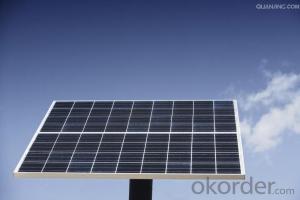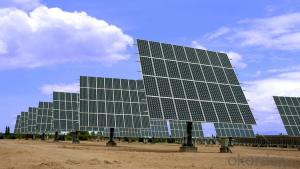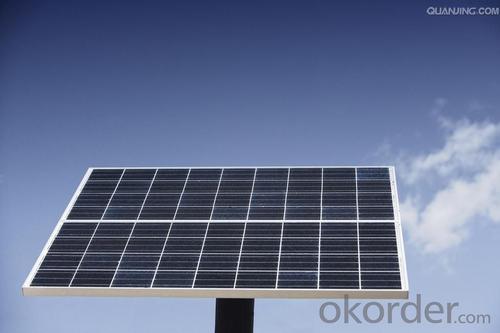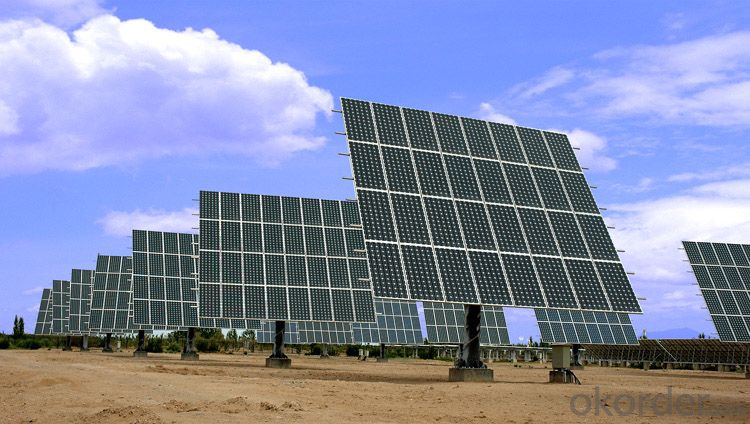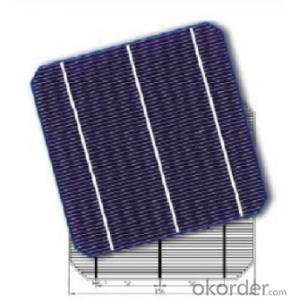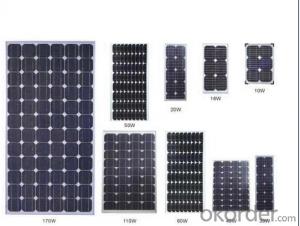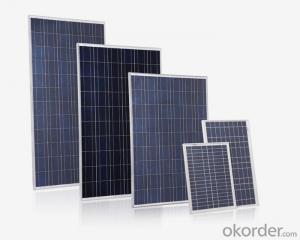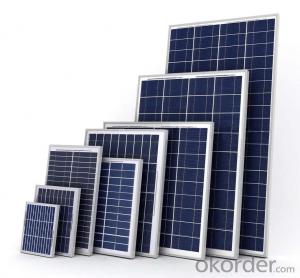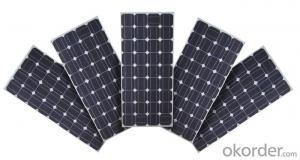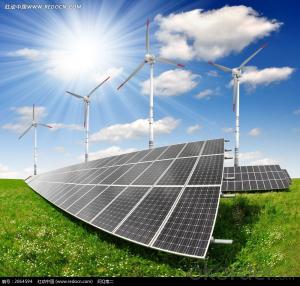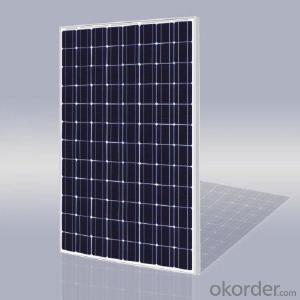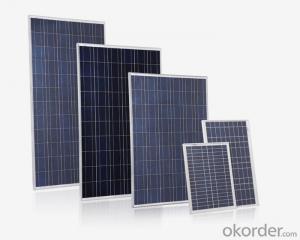Ingot Solar Cells Favorites Compare 250W Mono PV Solar Panel
- Loading Port:
- China Main Port
- Payment Terms:
- TT OR LC
- Min Order Qty:
- -
- Supply Capability:
- 10000000000000 watt/month
OKorder Service Pledge
OKorder Financial Service
You Might Also Like
Quick Details
| Place of Origin: | Guangdong China (Mainland) | Brand Name: | CAP | Model Number: | 50w100w150w200w250w300w |
| Material: | Monocrystalline Silicon | Size: | 1385*1035*75mm | Number of Cells: | 72pcs |
| Max. Power: | 300w | type: | solar panel | color: | blue&black |
| warranty: | 5 years |
Packaging & Delivery
| Packaging Detail: | standard export package for solar panel |
| Delivery Detail: | 7-15 days for solar panel |
Specifications
solar panel
High Efficiency
25 years Warranty
High-transmissivity low-iron tempered glass
Solar Panel
50w100w150w200w250w300w
Characteristics
1,High and stable conversion efficienly based on over 4 years professional experience
2 ,High reliability with guaranteed +/-10% output power tolerance
3,Proven materials,tempered front glass,and a sturdy anodized aluminum frame allow modules to operate reliably in multiple mountily configurations
4,Combination of high efficicncy and attractive appearance
Quality and Safety
1,25 year 80%,10 year 90% power warranty 3 year power warranty
2,ISO9001:2000 (Quality Management system) certified factory
3,Product Quality warranty & products Liability Insurance to guarantee and user' benefits
4,Certifications TUV Intercert, CE Temperature Coefficients
| Module Type | 100w | 150w | 200w | 250w | 300w |
| Maximum Power at ST(Pmax)W | 100wp | 150wp | 200wp | 250wp | 300wp |
| Maximum Power Voltage(Vmp)V | 36/18 | 36/18 | 36/18 | 30.8v | 36/18 |
| Maximum Power Current(Imp)A | 2.77/5.55 | 4.16/8.33 | 5.55/11.1 | 8.11A | 8.33/16.66 |
| Open Circuit Voltage(Voc)V | 39.5/19.05 | 39.3/19.4 | 39.6/19.5 | 36.2V | 39.6/19.8 |
| Short Circuit Current(Isc)A | 3.04/6.09 | 4.58/9.16 | 6.1/12.2 | 8.7A | 9.16/18.33 |
| Cell Efficiency(%) | 18.60% | 18.10% | 18.60% | 17.80% | 18.10% |
| Module Efficiency(%) | 17.70% | 17.20% | 17.70% | 17.10% | 17.20% |
| Operating Temperature°C | -40°C to +85°C | -40°C to +85°C | -40°C to +85°C | -40°C to +85°C | -40°C to +85°C |
| Maximum system voltage | 1000V(IEC)DC | 1000V(IEC)DC | 1000V(IEC)DC | 1000V(IEC)DC | 1000V(IEC)DC |
| Power tolerance | -0.03 | -0.03 | -0.03 | -0.03 | -0.03 |
| Temperature coefficients of Pmax | -0.45%/°C | -0.45%/°C | -0.45%/°C | -0.45%/°C | -0.45%/°C |
| Temperature coefficients of Voc | -0.27%/°C | -0.27%/°C | -0.27%/°C | -0.27%/°C | -0.27%/°C |
| Temperature coefficients of Isc | 0.05%/°C | 0.05%/°C | 0.05%/°C | 0.05%/°C | 0.05%/°C |
| Weight(kg) | 8 | 11 | 14 | 20 | 25.5 |
| Number of cell(pcs) | 4*9 | 4*9 | 6*10 | 6*12 | 6*12 |
| Dimensions(mm) | 1194*534*35/30 | 1580*808*50/35 | 1471*670*40/35 | 1640*992*50 | 2000*1050*50 |
- Q: Can solar cells be used in smart grid systems?
- Yes, solar cells can be used in smart grid systems. Solar cells can generate electricity from sunlight and can be integrated into the smart grid infrastructure to provide renewable energy sources. This allows for decentralized power generation and can help reduce reliance on traditional energy sources, making the grid more sustainable and efficient. Additionally, smart grid systems can enable the efficient management and distribution of the electricity generated by solar cells, further enhancing their integration into the grid.
- Q: What is the role of anti-islanding devices in solar cell systems?
- The role of anti-islanding devices in solar cell systems is to ensure the safety of utility workers and prevent damage to the grid in the event of a power outage. These devices are designed to detect when the grid loses power and immediately disconnect the solar system from the grid. This prevents the solar system from continuing to generate electricity and feeding it back into the grid, which could pose a danger to workers trying to fix the power outage. Anti-islanding devices also help to protect the solar system itself from potential damage caused by voltage fluctuations during an outage.
- Q: Can the 156x156mm high efficiency single crystal cells assembly function better compared to the traditional one?
- The media already commented a lot on the 156x156mm high efficiency single crystal cells assembly, which make me wonderabout its real function.
- Q: Can solar cells be integrated into building materials?
- Yes, solar cells can be integrated into building materials. This practice, known as building-integrated photovoltaics (BIPV), involves embedding solar cells into various architectural elements such as windows, roofs, or facades. BIPV allows for the generation of renewable energy without the need for additional structures, maximizing energy efficiency and aesthetic integration within buildings.
- Q: Friends are fuel cells are chemical energy into electricity, solar cells are converted into electricity into electricity I would like to know in addition to the structure and the conversion of different ways there are no other differences hope that the specific power of everyone
- fuel for a wide range of: fuel cells can be applied to large urban power stations, but also as hospitals, shops, collective dormitories, remote mountainous areas of small power generation devices, as well as daily and national defense machinery used in walking power system. The development of fuel cells in the future new energy halo application of the major direction, its development has great social significance and economic significance.
- Q: Can solar cells be used for powering oil rigs?
- Yes, solar cells can be used for powering oil rigs. They provide a clean and renewable energy source that can be harnessed to generate electricity for various operations on the rig, reducing reliance on traditional fossil fuel-based generators.
- Q: What is the impact of dust storms on solar cell efficiency?
- Dust storms have a significant negative impact on solar cell efficiency. The accumulation of dust on the surface of solar panels reduces the amount of sunlight that can reach the cells, leading to a decrease in power generation. The dust particles block and scatter sunlight, reducing the overall efficiency of converting sunlight into electricity. Regular cleaning and maintenance of solar panels are necessary to mitigate the adverse effects of dust storms and ensure optimal performance.
- Q: Can solar cells be used in charging electric bikes?
- Yes, solar cells can be used to charge electric bikes. By connecting solar panels to the bike's battery, the energy from the sun can be converted into electricity, providing a renewable and sustainable source of power for the bike's charging needs.
- Q: Can solar cells be used for desalination purposes?
- Yes, solar cells can be used for desalination purposes. Solar-powered desalination systems, such as solar stills and solar desalination plants, harness the energy from the sun to power the desalination process. This renewable energy source helps reduce the environmental impact of desalination and promotes sustainable water production.
- Q: Can somebody list some of the materials used for making solar cells?
- Silicon is one of the most important and expensive materials to make solar cells.
Send your message to us
Ingot Solar Cells Favorites Compare 250W Mono PV Solar Panel
- Loading Port:
- China Main Port
- Payment Terms:
- TT OR LC
- Min Order Qty:
- -
- Supply Capability:
- 10000000000000 watt/month
OKorder Service Pledge
OKorder Financial Service
Similar products
Hot products
Hot Searches
Related keywords
